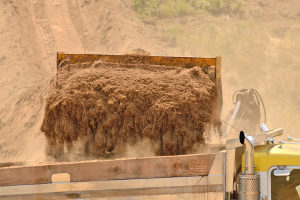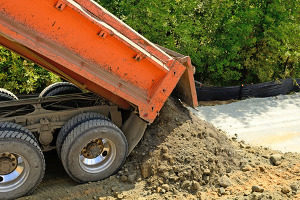 Fill dirt is a material that is used to fill in a depression on the ground, support a structure, or create slopes or mounds. This type of earthy material is often devoid of organic matter or any biological activity as the presence of organic material produces pockets of gas that affects the integrity and compaction of the fill dirt.
Fill dirt is a material that is used to fill in a depression on the ground, support a structure, or create slopes or mounds. This type of earthy material is often devoid of organic matter or any biological activity as the presence of organic material produces pockets of gas that affects the integrity and compaction of the fill dirt.
There are different types of fill dirt materials that are available depending on the type of project. The types of fill dirt include sand, rock, stones, and clay. Common uses of fill dirt are for highway maintenance, pavement building, raise the level of a building’s foundation, support retaining walls, and for gardening.
Types of Fill Dirt
There are so many types of fill dirt that you can opt for to finish your project. Choosing the type of material depends on the type of project that you have. Thus, below are the different types of fill dirt materials that are available today.
- Coarse grain soil: This type of fill dirt material includes gravels and sand. It provides good compaction yet has less plasticity and good drainage. It is well-suited on areas where heavy equipment can destroy the integrity of the structure. Examples of these structures are tunnels and culverts.
- Clay: Clay is a type of fill dirt that is characterized by having medium plasticity. It offers heavy compaction thus providing a stable support. The problem with this type of material is that it absorbs too much water thus affecting the stability of the structure that it supports.
- Rock: Rock is a fill dirt material that provides a lot of stability. The problem with this material, however, is that it is very expensive and requires a lot of labor to install.
Why Measure the Volume of Fill Dirt?
 Determining the right volume of the fill dirt that you are going to use for a particular project is necessary so that you will have just enough to carry out the project. The problem with not calculating the estimated volume needed is that you may have too little or too much of the material.
Determining the right volume of the fill dirt that you are going to use for a particular project is necessary so that you will have just enough to carry out the project. The problem with not calculating the estimated volume needed is that you may have too little or too much of the material.
While having not enough fill dirt can be addressed by getting more from the supplier, you still spend more on the logistics. Moreover, there will also be a downtime that you will experience especially if there are no more fill dirt available to continue the project.
Having an excess of fill dirt, on the other hand, is a waste of money as well as space. Where will you keep the excess fill dirt on your property without making it look unsightly? You can return them to the supplier but then, again, you waste on logistics.
How to Calculate the Volume of Fill Dirt
In a nutshell, determining the amount of fill dirt that you need for a particular project largely depends on the shape of the area that you want to be filled. For instance, if you have a rectangular area, you can multiply the three dimensions–length, width, and height. Other shapes can be quite challenging. Thus, below is a helpful guide on how you can calculate the volume of the fill dirt.
Rectangular Area
Measure the length, width, and depth of the area that you want to fill in with dirt. Make sure that the units that you used for all the dimensions are the same. This means that if you are using inches, then use inches all throughout. So, let’s say that you have 120 inches for the length, 60 inches for the width, and 30 inches for the height, then that is your total area in cubic inches.
 With these values, you get a total of 216,000 cubic inches. Now, it is important to take note that fill dirt is sold in cubic yards thus it is crucial that you know how to convert cubic inches to cubic yards. This can be achieved by dividing the value to 46,565 cubic inches to get the 4.63 cubic yards. This is the amount of the fill dirt that you need to finish your project. Moreover, make sure that you add a little extra margin of error by adding two extra cubic yards just in case. Please take note of the calculation below to understand it further.
With these values, you get a total of 216,000 cubic inches. Now, it is important to take note that fill dirt is sold in cubic yards thus it is crucial that you know how to convert cubic inches to cubic yards. This can be achieved by dividing the value to 46,565 cubic inches to get the 4.63 cubic yards. This is the amount of the fill dirt that you need to finish your project. Moreover, make sure that you add a little extra margin of error by adding two extra cubic yards just in case. Please take note of the calculation below to understand it further.
Given: length = 120 inches, width = 60 inches, height = 30 inches
Area of rectangle = l x w x h
Thus;
120 in x 60 in x 30 in= 216,000 cubic in
216,000/46,565 = 4.63 cubic yard
Circular Area
If you have a circular area, it is important that you measure the diameter of the whole and its depth. For instance, if the diameter of the whole is 60 inches (radius is 30 inches) and is 30 inches deep then you can calculate the area of the whole. To calculate the area, it is also important that you use the value of pi (3.142) as the constant. Don’t forget to convert the cubic inches to the cubic yard just like what was demonstrated for the rectangular area. Thus, below is the calculation that you can easily follow:
Given: diameter = 60 inches, radius = 30 inches, depth or height = 30 inches, π = 3.124
Area of circle = πr2h
Thus;
3.124 x (30 in)2 x 30 in = 84,834 cubic in
84,834/46,565 = 1.82 cubic yard
Knowing how much fill dirt you need is very important so that you have enough materials to use for your project. Calculating the volume of fill dirt is not rocket science and all there is to it is to use simple math. Make sure that you convert it to a cubic yard to get the final value.
But what if you don’t know how much you need as your area takes on an irregular shape? You don’t need to worry as you can seek help directly from the supplier of fill dirt. They can assess the area that needs to be filled and they will be the one to calculate the volume for you. If you are looking for dirt, topsoil and other materials Dirt Connections can provide for your needs, visit us at Dirt Connections today.












































